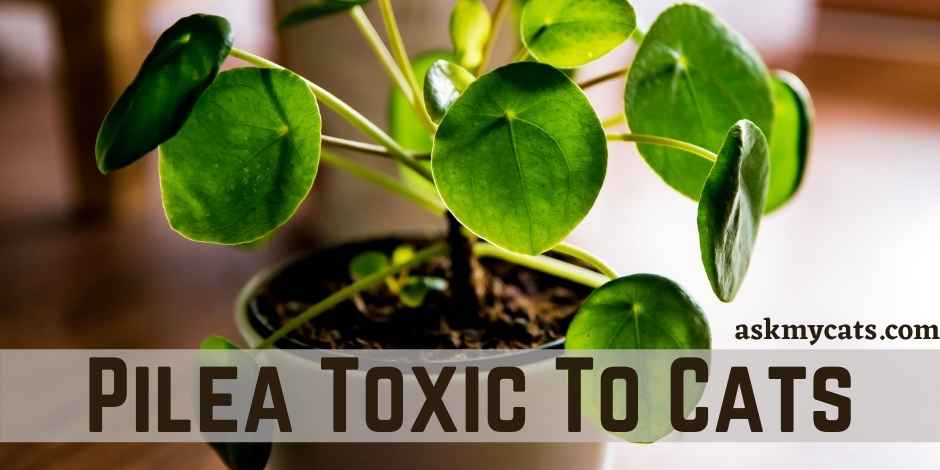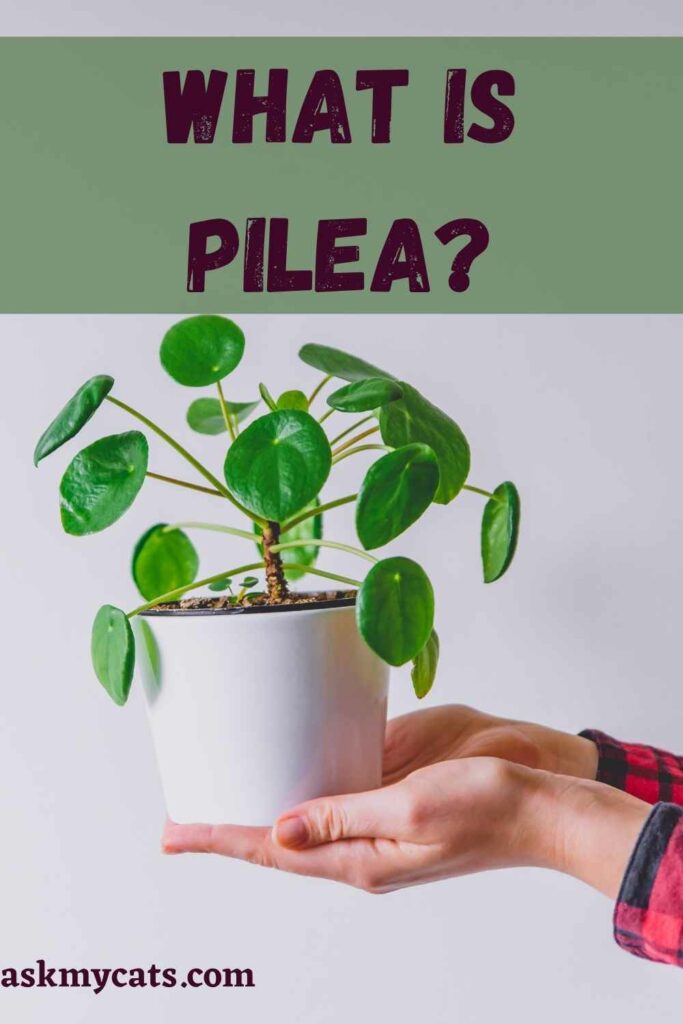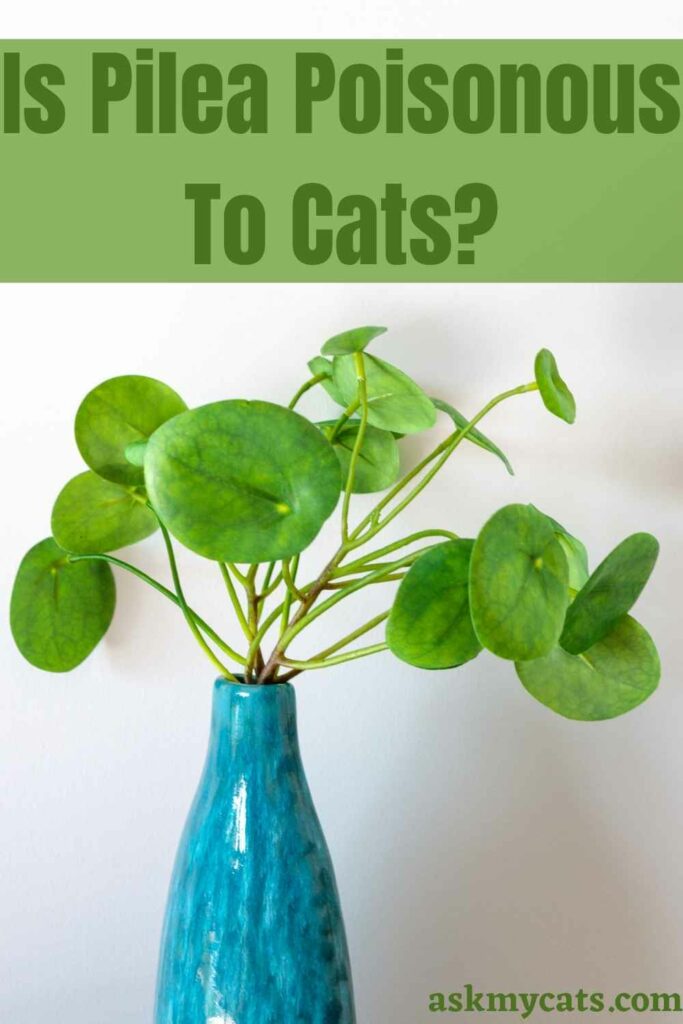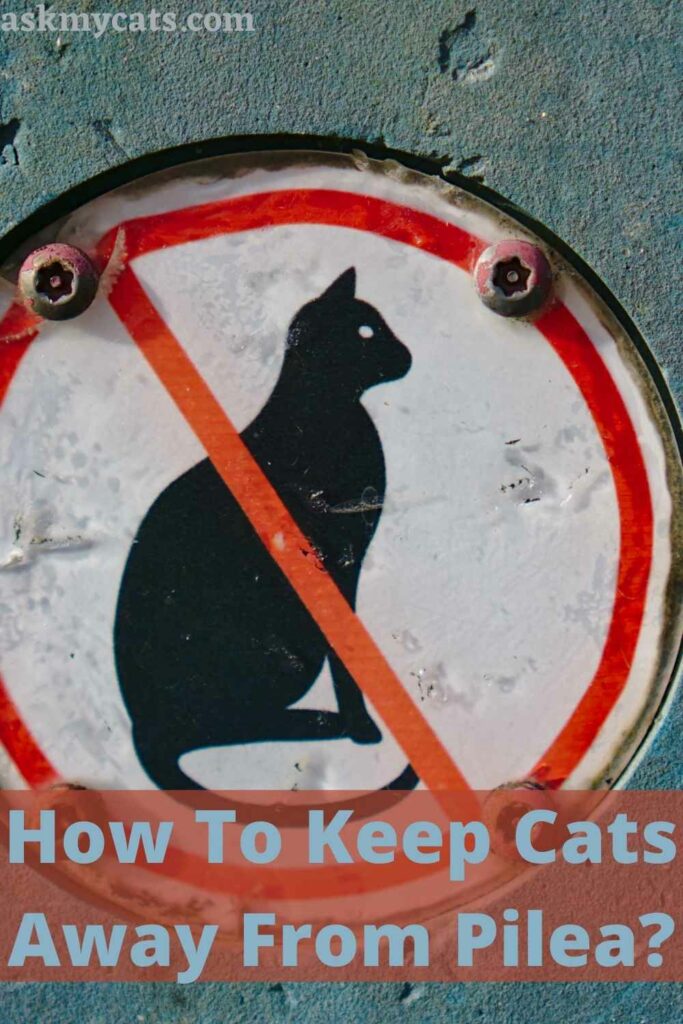Finding a houseplant that suits your home is difficult enough. Things are even more difficult for cat owners: we need non-toxic plants because many pets find indoor greenery irresistible.
So, is pilea toxic to cats?
No, pilea is not considered toxic to cats. Cats, dogs, other pets, and humans are not poisoned by members of the genus Pilea. If you have a furry friend who likes to nibble on your houseplants or a young child who likes to explore the world with their mouth, this plant is a great choice.
This article will talk about the relationship between pilea and cats.


Give Your Cat the Perfect Day
Get the Free Ebook!
What Is Pilea?
Pilea peperomioides (Chinese money) is a flowering plant in the Urticaceae family that is also known as missionary plant, lefse plant, pancake plant, UFO plant, mirror grass, or blender plant (the nettle family). It is native to Sichuan and Yunnan, popularly cultivated as a houseplant.

It’s simple to grow the Chinese money plant (done from plantlets offshoots that sprout from the trunk).
Small houseplants are simple to grow and maintain. The Chinese money plant, or Pilea peperomioides, has a Royal Horticultural Society Award of Garden Merit and is safe for cats, i.e., it is not toxic or poisonous to cats as it is to dogs, making it an ideal houseplant for people who have these pets.
In terms of lighting, a Chinese money plant thrives in bright light with no direct sunlight.
Leaves scorch in direct sunlight, but light shade may encourage larger leaves.
They’re said to be hardy to -20°F, and a period of cool weather may encourage them to bloom with their tiny white flowers on pink stems.
The flat, round leaves of the pilea plant help to identify it. Long, thin, red stems support gleaming, leathery, thick, dark green pancakes (hence the alternate name of pancake plant).
They aren’t particularly tasty, but they are certainly pleasing to the eye. This unusual plant reaches a height of about 40cm, and the stems begin to twist as it ages.
Money plants are well-known for bringing good fortune and wealth to the homeowners who look after them. The more prosperous the plant is, the more it will produce!
When you give a friend a clipping of your money plant, it is thought that you are bestowing wealth and prosperity on them. With little effort, the clipping will grow and bring great joy to whoever receives your thoughtful gift.
On the other hand, some folklore claims that clippings stolen from another homeowner can be used to grow a money plant. The thief will profit in this case, while the previous homeowner will lose money. It’s like stealing someone’s good fortune, so some homeowners guard their money plants.
Is Pilea Poisonous To Cats?
No, pilea is not considered poisonous to cats.

Cats, dogs, other pets, and humans are not poisoned by members of the genus Pilea.
This plant is a great choice if you have a furry friend running around the house who likes to nibble on your houseplants or a young child who likes to explore the world with their mouth.
It’s worth noting that ingestion of any plant can cause stomach upset in pets.
If your cat or dog ate your Pilea and took a big bite out of it, there’s a chance it caused vomiting or diarrhea. However, nothing out of the ordinary is to be expected.
Cats, after all, use their natural reaction to eating plants to get rid of furballs!
It’s disgusting, but it’s not a big deal unless it happens more than once or twice after eating.
Pilea is most pet owners favorite because it is completely pet-safe and non-toxic. This plant is known for giving birth to a large number of babies that can be propagated and shared with friends. Pilea prefers indirect light and is prone to overwatering.
Pilea peperomioides, also known as the Chinese money plant, pancake plant, or UFO plant, is fashionable, easy to grow, and safe for cats and dogs.
These plants were previously difficult to come by outside of Scandinavia. They are becoming more widely available as a result of their growing popularity.
Use sandy, well-draining soil to care for your Pilea. Allow the soil to dry between waterings. This type of indoor plant prefers a lot of indirect light but not direct sunlight.
It’s simple to grow the Chinese money plant (done from plantlets offshoots that sprout from the trunk). Small houseplants are simple to grow and maintain. Is it poisonous to cats?
Pilea peperomioides (Chinese money plant), also known as missionary plant, lefse plant, pancake plant, UFO plant, mirror grass, or blender plant, is a flowering plant in the Urticaceae family (the nettle family). It is a popular houseplant that is native to Sichuan and Yunnan.
The Chinese money plant, or Pilea peperomioides, has a Royal Horticultural Society Award of Garden Merit and is safe for cats, i.e., it is not toxic or poisonous to cats as it is to dogs, making it an ideal houseplant for people who have these pets.
Giving a pilea plant indirect sunlight and watering it thoroughly, allowing the soil to dry out a bit between waterings, is all it takes to care for it.
A money tree’s trunk is thin and often braided to add to its beauty. Missy is unlikely to be interested in the trunk, but she might be enticed to tug on the leaves as they blow in the wind created by your air conditioning vent, possibly gnawing on them for a tasty green snack. If she eats this money, don’t worry; it’s not toxic, according to the ASPCA.
Despite the fact that the pilea plant isn’t toxic to cats, the ASPCA advises against letting your cat chew on it. Missy’s stomach may become irritated if she eats this plant.
If your cat eats a non-toxic plant, it can cause stomach upset, coughing, and choking, especially if it’s a regular green treat.
How To Save Pilea From Cats?
To save pilea from cats follow these steps: –
When we bring new houseplants into our homes, we’re usually concerned about our cats’ safety, but with cat-safe plants like these, the greatest risk is to the greenery itself. There’s always the risk of the plant being gnawed on or even knocked over if it’s in a reachable location.
What should you do if a cat “attack” causes damage to your Pilea peperomioides? Even if a plant appears to be severely damaged, it has a good chance of surviving.
Some leaves were damaged, but there were no other issues: There’s no need to be concerned about removing the unsightly damaged leaves. Just give Pilea peperomioides regular attention and keep an eye out for new growth.
Broken stems: If your Pilea was split into two pieces, one still rooted in the planter and the other completely dislodged, this isn’t a big deal. Even if there are no leaves on the stem, it will sprout new foliage if left in the planter. Keep the soil lightly moist and place it in a light spot. Go to the article on Pilea peperomioides propagation to learn how to re-root the top part that has no roots. You’ve now got two Pilea plants!
Dislodged baby plants: No need to panic if your baby plants have become dislodged! Even if the baby Pilea plants were knocked off the mother plant a little earlier than you would have liked, they can usually survive and grow. Put them in water or return them to the mother plant’s container to root.
Complete chaos: Even if your Pilea plant was ripped to shreds, there’s a chance you can salvage something. Even if a stem is bare, it contains life if it has nodes and is at least an inch or two (5 cm) long. To see if it will re-root, place the stem piece in a shot glass with water and place it in a light spot.
Is Hydrocotyle Vulgaris Safe For Cats?
Yes, hydrocotyle vulgaris safe for cats.
Hydrocotyle vulgaris, also known as money plant, marsh pennywort, water naval, copper coin, or lucky plant, is a full indoor and outdoor plant that can grow in ponds and water gardens and is not toxic or poisonous to cats and dogs.
It is a member of the Araliaceae family and can survive in stagnant water up to two inches deep. Excessive watering, on the other hand, will still cause root rot, contrary to popular belief.
Is Lunaria Toxic To Cats?
No, lunaria is not toxic to cats.
Other plants commonly referred to as money plants belong to the genus Lunaria and the family Brassicaceae (cabbage, crucifers, or mustard family). Lunaria biennis and Lunaria annua are two common examples.
Lunaria species are also known as Chinese money, money plant, and Pope’s money. Cats and dogs are not poisoned by lunaria.
Can Cats Eat Jade Plant?
No, cats should not eat jade plant as it is considered toxic as per ASPCA.
Crassula ovata, also known as jade plant, money tree, money plant, Chinese rubber plant, jade tree, Japanese rubber plant, baby jade, dwarf rubber plant (not to be confused with baby rubber plant), and lucky plant, is a common houseplant in the Crassulaceae family. Unfortunately, the jade plant is toxic to cats, dogs, and horses, as well as mildly toxic to humans through skin contact.
Depression, vomiting, and incoordination are common toxicity symptoms in these pets. However, the cause of the toxicity is unknown.
Is Pachira Aquatica Toxic To Cats?
No, pachira aquatica is not toxic to cats.
Pachira aquatica, which belongs to the Malvaceae family, is another plant known as money plant or tree plant. Malabar chestnut, Guiana chestnut, French peanut, Saba nut, Provision tree, Pumpo, and Monguba are some of its other names.
Cats and dogs are not poisoned by Pachira aquatica, a popular tropical ornamental plant that cannot tolerate frost.
How To Keep Cats Away From Pilea?
You can keep cats away from pilea by having some shelves erected and keep your plants up high out of reach of the cat.

Build some shelves and keep your plants up high and out of the cat’s reach.
This way, you can intersperse the money trees with other plants to create a variety of foliage that looks cool and inviting.
Hanging baskets can be used to good effect in moist humid areas such as a bathroom, and they will also keep the cat out of reach.
There are numerous beautiful ways to arrange your indoor plants, including green walls in well-lit areas where your cat cannot reach.
If some rooms are off-limits to the cat, remember to keep the door closed and keep him in his designated areas.
Cats enjoy chewing on various objects, so make sure he has a ‘cat chew’ to keep him occupied.
Also, make sure your cat gets plenty of exercise. Take him to the park at least twice a day for a good run, and he’ll be tired and not looking for something to chew on when he’s at home.
A short walk around the block is not enough for most cats, and they prefer a longer, more interesting walk, and they frequently like to chase a ball or frisbee when they go to the park.
Many cats have a working heritage, such as sheepdogs and other herd dogs who protect and guard their flocks. It is especially important to keep your cat busy with Kelpies because they frequently try to ’round you up.’ If you are unable to take him for a long walk twice a day, hire a cat walker to take him to the park.
How To Tell If Your Cat Has Eaten Pilea?
You can tell if your cat has eaten pilea by: –
If you have an indoor cat, you’ll quickly notice if he’s been eating the money tree leaves, and it’s always a good idea to have a first-aid kit on hand in case anything goes wrong. If you see any half-chewed money tree leaves lying around, he has most likely tried to eat some and is suffering from a digestive upset as well as a sore, swollen mouth.
A pet first aid kit is a great gift for a pet lover and can be purchased online. The kit contains fresh 3 percent hydrogen peroxide to induce vomiting in your cat if he or she has eaten something poisonous (before you give it to the cat phone the Vet and check that it is necessary).
Depending on how much the cat has eaten, hydrogen peroxide may not be required. You will have peace of mind if you have a pet first aid kit. If your veterinarian says no action is necessary, which is likely, make sure your cat drinks plenty of water to flush his system.
Frequently Asked Questions
What are the health benefits of pilea?
There are many misconceptions about pilea health benefits in terms of reducing stress, creating an atmosphere, and bringing calm. Viewing nature, also known as biophilia, has numerous health benefits. Many hospitals have pictures of nature because it makes people feel better and helps them recover faster. Please understand that we’re referring to the calming properties of these plants. Some plants commonly referred to as pilea are actually poisonous if consumed. When ingested by dogs, cats, or small humans, they often do not kill you, but they do cause vomiting and illness symptoms. Before bringing a plant into your home, make sure you know what species it is.
What house plants should cats avoid?
Many plants can be harmful to your cat if eaten, and just because one variety is safe for your cat doesn’t mean all varieties are. For example, asparagus fern is a mildly toxic plant. Cycad, also known as fern palm or sago palm, is a toxic plant that isn’t actually a fern. Missy should avoid lucky bamboo (Dracaena sanderiana) and heavenly bamboo (Dracaena sanderiana) (Nandina domestica). Dieffenbachia, also known as dumb cane, is poisonous to cats. Ivy should be avoided because different types can cause everything from minor irritations to vomiting, diarrhea, and gas. Contact your veterinarian if your cat eats a plant and you’re not sure if it’s toxic or if she shows signs of distress. Bring a sample of the plant with you to the vet to aid in the diagnosis.
Are bamboo plants toxic to cats?
Bamboo is not poisonous to pets, unlike many other common plants. Dogs, cats, and horses are not poisoned by bamboo. If your pet ingests or comes into contact with a poisonous plant, you should have an emergency kit on hand to treat any serious consequences.
Final Words
For a variety of reasons, cats enjoy nibbling on greenery such as your pilea. The leaves are sometimes too much of a temptation to resist during play, and other times a cat may graze to calm an upset stomach. Plants should be kept out of your cat’s reach.
Try spraying plants with a bitter non-toxic spray if she’s an acrobat and can reach out-of-the-way spots. Providing her with her own cat grass or herbs to chew on could help her focus. If your cat eats plants, never hit or punish him.
If you have any questions, ask us in the comments section.
